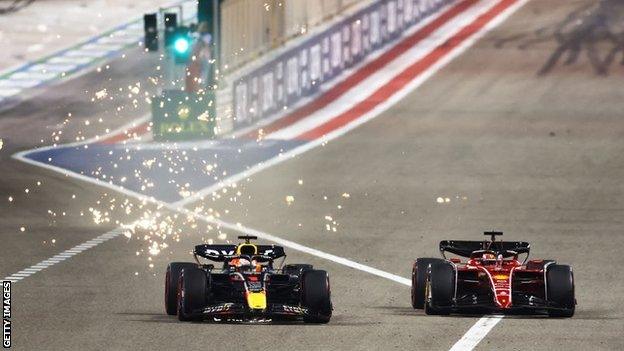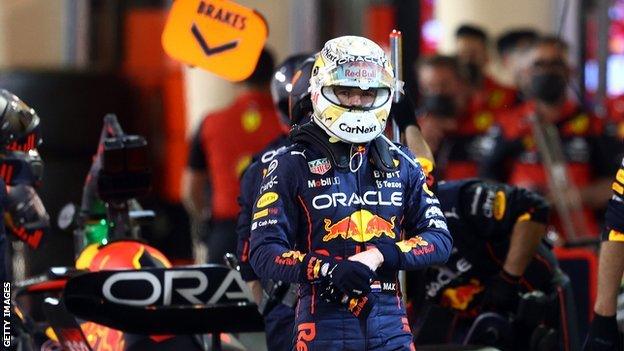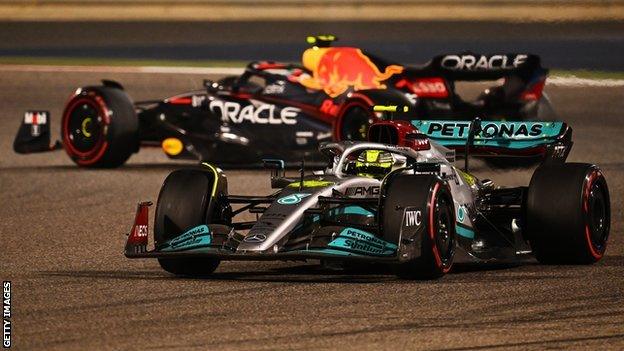Bahrain Grand Prix: Ferrari are finally back - can Charles Leclerc mount title challenge?
- Published

The Saudi Arabian GP is live on 5 Live and the BBC Sport website
If the battle between Charles Leclerc and Max Verstappen is any measure of the season to come in Formula 1, it is going to be quite a year.
Mercedes' struggles with their car after the huge change of regulations for 2022 have taken Lewis Hamilton out of the title battle - for now, at least, and possibly for the year if his team cannot find some rather large solutions quickly.
But Leclerc and Verstappen staged a gripping contest in the Bahrain Grand Prix. They raced wheel to wheel for two laps, swapping the lead five times, before the Ferrari driver came out on top.
If their battle was the highlight of the race, it was not the most dramatic moment. That was saved for the final three laps, when both Red Bulls retired with the same problem - something to do with the fuel system, the team said - and lost second and fourth places.
Leclerc's consummate victory - a drive that had pace, control, maturity, coolness and aggression - has put him in a strong position but it means little at the start of F1's longest ever season other than one very important point: Ferrari are back with a bang.
A renaissance at Maranello
It has been a long road back to this point for F1's most famous team. They were last absolutely competitive in 2017 and 2018, but let those titles slip through their fingers with a series of mistakes from the team and their then lead driver Sebastian Vettel.
The following year had its highlights - Leclerc scored more pole positions than anyone and won two races - but it was clouded by a controversy over their engine.
They lost performance over the final races after a rule clarification over usage of the hybrid system, and over the following winter it was revealed that they had come to a private settlement with governing body the FIA, which said it had doubts the engine had always been run legally.
In 2020, their engine took a huge step backwards in power. They made progress in 2021. But their lack of competitiveness in those seasons ensured they always saw 2022's rules reset as a chance to bounce back to the front. On the evidence of Bahrain, the work and focus has paid off.
The Ferrari - at least in Leclerc's hands - was the quickest car in Bahrain. But only just. He beat Verstappen to pole by just over 0.1 seconds and had a small but ultimately decisive advantage in the race.
Leclerc was able to answer everything Verstappen threw at him. He edged away in the first stint. He was able to fight back past the Red Bull twice after Verstappen closed up with an earlier first pit stop - helped by an error by Leclerc on his in-lap and a sticky wheel change - and once back in front was always in control.
Ferrari gave themselves more margin for the second stops - a larger lead before them, and a better in-lap from Leclerc were followed by a faster stop. A safety car threatened to undo all the good work, but Leclerc handled the restart consummately.
"We were sure we would be in a better position but we didn't know where," he said. "And now we see we are in the mix to fight for the title, it's amazing. We are both very happy to have a car capable of winning. And we will fight for it for sure."
It's been clear for a long time that Leclerc is a potential world champion if only he could get his hands on the right car. The guy is so fast, and he races hard. This was a brilliant drive, and he was miles clear of team-mate Carlos Sainz for most of the weekend, the Spaniard admitting he needed to work hard to understand where his deficits were coming from.
A brutal day for Red Bull

Red Bull had been favourites coming into the race
Red Bull had been favourites coming into the race, but in the end Verstappen could not deliver on that status.
Some questioned Verstappen's tactical approach to their battle after the first pit stops. Why keep trying into Turn One, some wondered, when he knew Leclerc would have the DRS overtaking aid to get him back into Turn Four? Wouldn't it have been better to try into Turn Four?
But ultimately it made no difference. For one, Verstappen had cooked his brakes in the fight and needed to "let Charles go" to cool them down. For another, a track rod was bent after his second pit stop, which gave him uneven steering. And then there was the mysterious problem that ended the races of both him and team-mate Sergio Perez.
Verstappen said: "It looked like there was no fuel coming to the engine and everything just turned off so I just rolled into the pit lane."
Team boss Christian Horner blamed "an issue within the fuel system" but was not immediately more specific than that.
Rivals, though, believed the team had messed up. They had not done a single race distance in six days of pre-season testing, it was said. Was this a consequence of a lack of preparation?
Horner said they "know the fuel was in there". But it sounds like the system was not getting it to the engine. And 30 points have now gone begging.
In all of this, Verstappen was not a happy man, even before the breakdown.
He did not like the car balance. He complained about the strategy, said he regretted following instructions and not pushing hard on his out laps from the pits, believing he could have passed Leclerc if he had. Horner pointed out if you took more out of the tyres early in the stint, you pay at the end.
"We just didn't quite have their pace today," Horner said.
There were those who suggested that Red Bull's problems were karma after the events of Abu Dhabi last year. Hamilton would not rise to that one: "I don't have a response. I am just focused on our job."
And Mercedes team boss Toto Wolff also shrugged it off: "The importance of the race in Abu Dhabi was greater than the importance of this race here as the opening of the 2022 season. I don't wish anybody that. It was certainly a brutal race for them."
Mercedes up against it

Lewis Hamilton claimed third after Red Bull's Sergio Perez retired
Red Bull at least know they have a quick car. The same cannot be said of Mercedes. At least not yet.
Hamilton benefited from the misfortunes of Verstappen and Perez and took a podium position very few would have predicted before the race.
But the realities of Mercedes' plight are clear. The car is something like 0.8 seconds a lap off the pace or possibly a little more in the race. The team believe it has potential but that is a lot of potential to unlock.
Mercedes' pace is defined by the ride-height at which they have to run their car to stop it suffering from "porpoising" or high-frequency bouncing on the straights.
The new rules make it advantageous to run the cars low but this can trigger the problem. Raising the ride-height is the way to fix it but this makes the car slower.
But all the cars are prone to porpoising if run too low. It is just that the Mercedes is slower than the Ferrari and Red Bull when in the set-up needed to reduce it.
Right now, the team do not have answers to their problems. Is it that they will be able to be competitive if they can find the floor modifications needed to change the airflow to bleed off downforce above a certain speed to stop the porpoising as it happens, as Ferrari and Red Bull are believed to be doing?
Or is it that the car is just not very good at the moment and simply does not have enough downforce?
There are further questions about the Mercedes engine, after all their cars were towards the bottom of the speed trap times. But Mercedes believe it is not so much that they have lost performance, more that Ferrari and Honda have gained it over the winter and that there is now nothing to choose between the three engines, whereas last year Mercedes had an advantage.
"We need to analyse the drag levels first before we really make a judgment of whether we are lacking power," team boss Toto Wolff said. "I don't think there are big differences in the power unit but clearly Ferrari made a big step forward because last year they weren't totally competitive and it looks at this single event as if they've out-performed everyone else."
"It is going to be such a hard battle," Hamilton said. "But we love a challenge, I really do enjoy a challenge."
It's a good job. Because this one looks as big as any he has had for a long time.
But it is less than those facing Mercedes customers McLaren and Aston Martin. They had awful weekends and were among the slowest cars out there. It was something of a shock to both and there will be a lot of furrowed brows as they try to work out what has gone wrong.
Have the rules worked?
The new rules were introduced to bring the field closer together and to make racing and overtaking easier. Have they worked? It's too hard to say right now.
There is still a sizable gap between the two fastest teams and the rest of the field.
The drivers agreed that it was perhaps a little easier to follow more closely behind another car. Perhaps this was a factor in allowing Leclerc and Verstappen to battle for two whole laps in the way they did.
Hamilton was also able to stick with Perez for a surprisingly long time early in the race. But he dropped back - and he did so partly because his car lacked the inherent pace, but also because he had rooted his tyres.
And this is the biggest concern. Privately, some drivers were damning about the new Pirellis. F1's tyre supplier was supposed to be designing tyres that were more robust and allowed drivers to run closer to the limit in races for longer and race harder with other cars.
But the margin between qualifying lap times and those in the race was little different to last year and degradation remained high.
It is far too early to make any definitive conclusions about either the car changes or the tyres. Perhaps things will look different in future races. But for now it does not appear as if racing has been revolutionised by the new rules.

Can this mystery finally be resolved?: 50 years on the case of a beachside abduction rumbles on
Jobfished: The bizarre story of a company that conned its own staff into believing it was real

